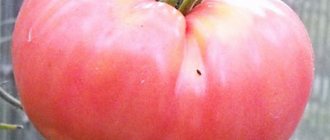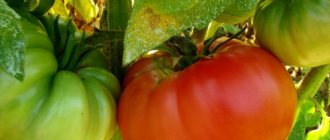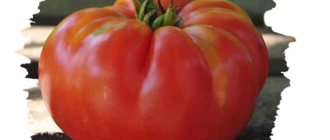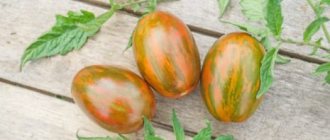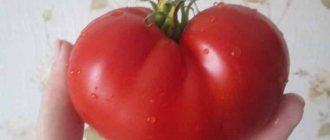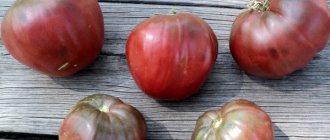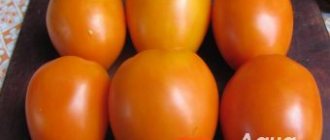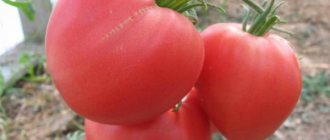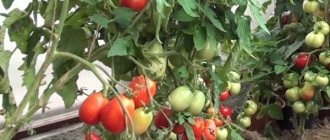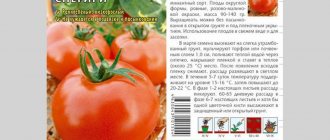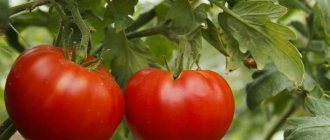Tomato Moskvich, the description and characteristics of the variety presented in this article, will become a favorite for residents of regions with short summers. Compact bushes of the Moskvich tomato variety produce an early harvest of delicious tomatoes at the beginning of summer. In addition, the variety is unpretentious in care and tolerates changing weather conditions well. The following describes all the characteristics of the variety, its advantages and disadvantages, as well as reviews from gardeners who have already grown the Moskvich tomato and share their experience.
Description and characteristics of the variety
The Moskvich tomato variety was developed by breeders at the Vavilov Institute in 1976. Many Russian gardeners liked it due to the possibility of growing it in any region of the country, since the variety is resistant to low temperatures and early fruit ripening.
- Moskvich tomatoes are cold-resistant, high-yielding varieties.
- Suitable for cultivation in regions with short and cold summers.
- Early ripening. The fruits ripen 90-95 days after emergence.
- Determinant. The bush grows 30-40 cm in height in open ground, and up to 50 cm under film cover.
- The bush is compact, standard, with an average number of leaves.
- The leaves are small, with pronounced veins, and dark green in color.
- Each cluster produces 4-6 fruits.
- Resistant to major nightshade diseases such as late blight, alternaria, fusarium and verticillium wilt.
- High yield , per 1 sq. m harvest 10-14 kg of ripe fruits.
Tomato diseases and methods of combating them
Late blight
Tomato late blight
A disease that very often affects tomatoes. It is formed due to high humidity and constant changes in air temperature. After watering, the water evaporates and settles in the form of drops on the leaves. If left untreated, the disease rapidly spreads throughout the bush, damaging leaves, fruits and neighboring plants.
For treatment use: Fitosparin or Barrier.
Dry spotting
Dry spotting (macrosporios) of tomato
The disease is caused by microsporios. The fungus attacks tomatoes due to high temperatures. The whole bush gets sick at once. Dark spots appear on the fruits, and the greens begin to dry out. The bush can be cured only by treating the plant with preparations that contain copper.
Tomato necrosis
Symptoms of tomato stem necrosis
The disease affects the stem of the plant, forming numerous cracks on it. If you do not start saving the plant, it will die before the fruits ripen.
get rid of necrosis of tomatoes by spraying with Fitolavin solution.
Fruit characteristics
- Tomatoes are small, one fruit weighs 60-80 g.
- The shape is round, slightly flattened at the stem and nose. The stalk has slight ribbing.
- Unripe tomatoes are brown-green in color. Ripe fruits become bright red.
- The skin is dense.
- The pulp is fleshy and juicy.
- There are 5-6 seed chambers inside, which contain few seeds.
- the concentration of dry substances is about 6%, sugars – up to 3%.
- The taste is rich tomato, sweetish.
- The fruits have good keeping quality and resistance to long-distance transportation.
- Tomatoes ripen well outside the bush at room temperature, maintaining their taste and external qualities.
Photo
Below are photos of the Moskvich tomato variety with fruits on the bushes and in cross-section.
Harvesting
Characteristics
Juicy, fleshy pulp.
The fruits are perfectly stored. Their purpose is universal: on the one hand, they allow you to enjoy the taste and aroma of fresh tomatoes at a time when other varieties are just beginning to set fruit. On the other hand, you can make tasty and healthy preparations from tomatoes of this variety; sauces and ketchups are especially popular in the summer.
Moskvich is an early ripening variety. The first harvest is obtained in early July.
Pick the fruits as soon as they are ripe. Overripe tomatoes can cause tomato infection. You can also pick unripe fruits. They can also ripen at home.
Moskvich tomatoes are good fresh. But they are best suited for preservation. Their small size makes them easy to fit into any size jar.
Features of cultivation
Moskvich tomatoes, like other early-ripening varieties, are best cultivated using seedlings. Before sowing, which takes place at the end of March, the seeds are soaked in a solution of potassium permanganate to disinfect them, then washed in warm water and soaked again, but in a growth stimulator. To do this, it is recommended to use the drug Zircon, the effect of which can be read in the article: Preparation Zircon for plants: instructions for using a growth stimulator.
The soil for planting should consist of garden soil, peat or humus, taken in equal proportions.
Seeds are sown to a depth of 1.5-2 cm, sprinkled with peat and watered with warm water. When 2-3 true leaves are formed on the seedlings, it is picked up and liquid complex fertilizer is applied.
Seedlings are planted in open ground in late May - early June. It is pre-hardened for 14 days. At first, plantings can be covered with film until they are completely strengthened and the soil is well warmed up.
The bushes are planted at intervals of 30-40 cm from each other, the distance between the rows should be at least 60 cm. Bushes of this variety do not need to be tied up or formed, but it is recommended to remove the lower leaves to improve ventilation.
More information about growing tomatoes is described in the article: Technology of growing tomatoes. Secrets of planting and care.
You might be interested in: How to properly plant tomatoes in a greenhouse: bush formation diagram, care features, photos and videos
Useful information: How to properly tie tomatoes in open ground: the best methods, step-by-step photo and video instructions
Review of the Moskvich tomato variety
What summer resident, and even more so a villager, would not want to grow tasty and juicy tomatoes on his or her plot.
And how you want to try the first fruits early, so as not to be tempted anymore by store-bought beauties that turn out to taste absolutely nothing. But the majority of Russian citizens live in conditions in which tomatoes often cannot be grown without a greenhouse. And what can we say about open ground, and even about the early harvest.
But there are, in the vast Russian expanses, varieties of tomatoes that not only were bred many years ago, but also that during their formation the emphasis was placed precisely on cold resistance. One of these old tomato varieties, proven for decades, is Moskvich.
And, despite its capital name, it makes the most sense to grow it in the northern regions, the Urals and Siberia.
Description
The Moskvich tomato variety was bred back in the distant 70s of the last century by domestic breeders at the Gorki Leninskie scientific and experimental base.
The tomato was obtained by crossing the Nevsky variety with Smena 373, while simultaneously being exposed to low temperatures.
Moskvich tomato fruits
The Moskvich variety is super-determinate, standard, and grows only 30-45 cm in height.
It is zoned exclusively for open ground, and although it can of course be planted in greenhouses, there is no practical sense in this. The only thing that makes sense for the northern regions is to use film shelters on arcs, since the height of the bushes is very small.
The variety is characterized by exceptional early ripening; it takes about 85-95 days from germination to the appearance of the first ripe tomatoes.
The bushes are quite compact, but at the same time strong. The leaves are small, dark green, highly corrugated. The inflorescence is simple and short.
The Moskvich variety has increased resistance to low temperatures, and therefore is intended, first of all, for cultivation in regions with unstable and unpredictable weather conditions.
The yield of Moskvich tomatoes is quite high for early ripening varieties. From one square meter of planting you can get up to 4-5 kg of fruit. And most importantly, the yield is practically not affected by unfavorable weather turbulence.
Productivity of Moskvich tomatoes
The fruits are formed on small clusters, each of which produces up to six tomatoes.
Moskvich tomatoes also have increased resistance to many diseases: late blight, various rots, verticellium wilt, fusarium and alternaria.
Productivity
The shape of the fruits of this variety is usually quite regular, flat and round.
The fruits are small, weighing on average 65-90 grams.
At the stage of technical maturity, they are brown-green with a small dark spot at the base. Fully ripened tomatoes have a uniform bright red color.
The skin is smooth and dense, but this does not affect the taste. The pulp is characterized by both juiciness and meatiness. There are few seeds in the fruits, but despite this, they can still be collected and the variety sown in subsequent years while maintaining all its properties.
The taste characteristics are not bad for early varieties. Tomatoes have a sweetish, rich taste, without wateriness, containing up to 6% dry matter, including about 3% sugar.
Juicy, fleshy pulp. The fruits are perfectly stored. Their purpose is universal: on the one hand, they allow you to enjoy the taste and aroma of fresh tomatoes at a time when other varieties are just beginning to set fruit. On the other hand, you can make tasty and healthy preparations from tomatoes of this variety; sauces and ketchups are especially popular in the summer.
Moskvich tomatoes are also distinguished by good transportability due to their dense peel.
For most northern regions, traditional cultivation of this variety of tomatoes in open ground is quite accessible. To do this, seeds are sown for seedlings at the end of March or even at the beginning of April.
When the first true leaves appear, the sprouts are transplanted one at a time into separate fairly spacious containers with fresh fertile soil.
Preparation for prevention against fungal diseases of tomatoes
Despite the resistance of this variety to various diseases, it is advisable to treat the plants prophylactically before planting in the ground with biofungicides: phytosporin or gliocladin. These substances are of organic origin, so they will not negatively affect the taste and composition of the fruit, but they can provide additional protection in case of a cold and rainy summer.
Moskvich tomato plants are planted in the ground maintaining a distance between bushes of 40 cm, while the rows are spaced 50 cm apart. In principle, this variety can be planted with a density of up to 7-8 plants per square meter.
Even in the conditions of the middle zone, you can try planting tomatoes of this variety in garden beds in May, covering them only with film from possible frosts.
Seedlings are indeed capable of withstanding a short-term cold snap down to zero or several degrees below, but they will grow much faster, which cannot but affect the early harvest.
The method of pinching Moskvich tomato bushes is special. It is only necessary, from the moment the first cluster is formed, to remove all unnecessary shoots below it, and in this case further pinching will not be necessary.
With this kind of pinching you get clusters with fruits like this:
This is a great advantage for beginners and for those who cannot devote extra time to caring for tomatoes. And the first brush is usually planted above the 6-8th leaf, so theoretically this is possible even at the seedling stage. Subsequently, brushes are formed through one or two sheets.
You can start tasting the first fruits at the end of June, and under favorable conditions and regular feeding, tomatoes can form on the bushes until early to mid-August.
Description
Tomato fruits Moskvich The Moskvich variety is super-determinate, standard, and grows only 30-45 cm in height.
